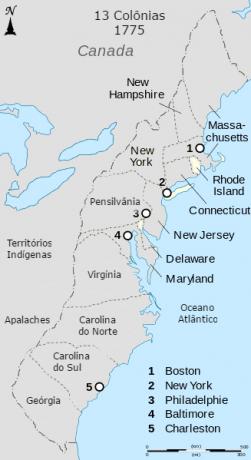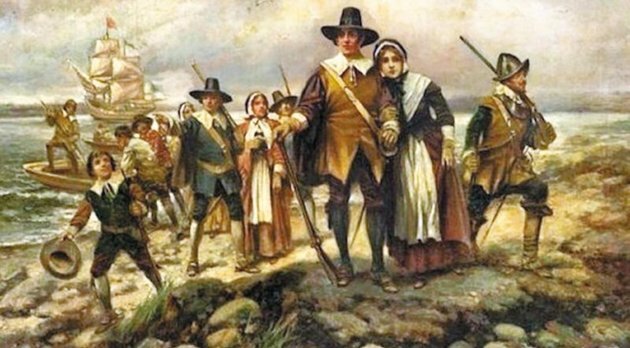At 13 colonies they were settlements installed by the British, on the east coast of America, during the 17th century.
The colonists settled between the Atlantic Ocean and the Appalachian Mountains, constituting the embryo of the future thirteen American states.
The Thirteen Colonies
Located on the Atlantic coast, the thirteen colonies developed differently from each other and deeply marked the formation of the United States.

The thirteen colonies consisted of:
- North Caroline
- South Carolina
- Connecticut
- Delaware
- Georgia
- Rhode Island
- Massachusetts
- Maryland
- New Hampshire
- New York
- New Jersey
- Pennsylvania
- Virginia
Formation of the Thirteen Colonies
Officially, English colonization began in 1607, with the founding of the city of Jamestown, Virginia.
The occupation took place during the 17th century, when Great Britain was experiencing a period of revolutions and political and religious disputes.
For disagreeing with the absolutist and theological ideas discussed during the Puritan Revolution
, groups of Protestants, Calvinists and Presbyterians left Britain and found a new home in America to escape persecution.This territory belonged, according to the Treaty of Tordesillas, to the Spanish crown. However, at that time, the Spaniards were busy conquering the region that today represents Mexico and Peru and ended up not occupying this zone.
Still, the Spaniards settled in Florida in 1565 and on the west coast.
Characteristics of the Thirteen Colonies
According to geographic location, the colonies on the east coast of North America can be divided into three: northeast (New England), central and south.
Each of them developed a different socio-economic profile. Let's see:
North East Colonies (New England)

The northern region of the 13 colonies was called New England and comprised the territories of Massachusetts, Delaware, Connecticut, Rhode Island and Maine.
Settlers flocked there especially in search of religious and political freedom. Thus, they developed a very strong link between religion and politics, as decisions were made in church assemblies.
The climate was hostile and agriculture was unprofitable. In this way, the settlers dedicated themselves to fishing and catching whales, making the port of Boston the main port of exit and entry for products.
Although free labor was predominant, there were enslaved Africans who did the housework. Some were free, but still treated less than a white person.
Colonies of the Center

The center colonies were formed by New York, New Jersey, Pennsylvania and Delaware.
In this area there was occupation by the Dutch, Swedes and Germans, who were gradually expelled by the British settlers.
In this region, the climate was more favorable for cultivation, and both subsistence agriculture and that which allows the sale of surpluses were developed.
Slave labor coexisted with free labor. Likewise, textile and steel factories were set up.
Commercial exchanges took place between Spanish and Portuguese colonies in South America, which included human trafficking with Africa.
Southern colonies

The southern colonies consisted of Maryland, Virginia, North Carolina, South Carolina and Georgia.
Unlike the northern colonies, the exploited areas in the southern region of the east coast had a distinct occupation. In this region, the climate was subtropical, which favored the implementation of monoculture products such as rice, cotton and tobacco.
In the south, it was more common for agricultural work to be carried out by enslaved blacks. Production was basically export-oriented, and based on large property.
Independence of the Thirteen Colonies
The colonies were administered by governors appointed by the English king. Governors received advice from an assembly elected by colonists that was responsible for collecting taxes.
From the beginning, the British colonies in America had political and administrative autonomy compared to the Spanish and Portuguese model.
This ended up generating an awareness in the colonists that they didn't need England to develop. Two centuries later, this thought would be the inductor of the Independence process.
Main causes of independence
The independence process of the Thirteen Colonies took place throughout the 18th century and had as a backdrop the territorial disputes between English and French settlers.
THE Seven Years War, which heightened Britain's financial crisis, caused the British to increase taxes levied in the thirteen colonies in order to cover war expenses.
In addition, the settlers also feared that the metropolis would not come to their aid in case of indigenous attacks, which ended up causing a feeling that they had been "forgotten" by the metropolis.
With the spread of Enlightenment ideas from Europe and its message of political freedom, the colonists understood that they could dispense with the British government.
The trigger for formalizing independence was the Stamp Duty established by Great Britain and the imposition of a monopoly on the sale of tea to the East India Company, without the approval of the colonists.
See more on this subject. read:
- U.S
- United states's flag
- North America
- Calvinism

